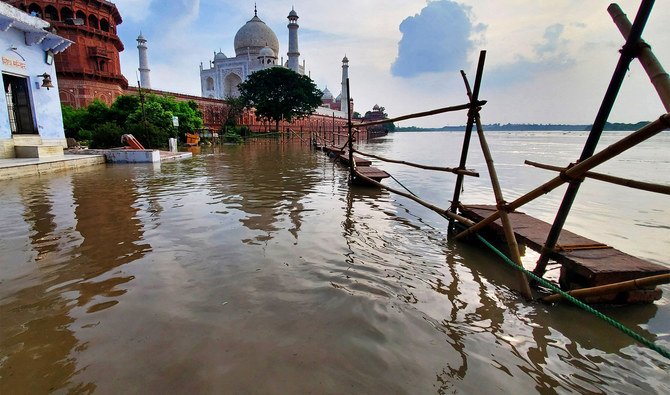Indians watched with alarm this week as the surging Yamuna River reached the outer walls of the country’s most recognizable landmark — the white-marbled Taj Mahal — for the first time in 45 years, due to heavy monsoon rains that have wreaked havoc and killed scores in the north of the country.
Apart from highlighting the vulnerability of the 17th-century mausoleum in Agra, into which officials on Wednesday assured media the water was unlikely to enter, flooding has disrupted life across several states in recent weeks. Tens of thousands of people have been displaced, roads have caved in, homes have collapsed, and schools have been forced to close. Waist-deep water at Kaziranga National Park sent rare one-horned rhinos, elephants and deer fleeing to nearby villages, authorities said.
A State Bank of India report this week made an early estimate of economic damage at nearly $2 billion.
The crisis comes in a year when many parts of the world are experiencing severe heat waves and other extreme conditions attributed to climate change. Although flooding is nothing new in India, experts warn that global warming means the country can expect more extreme weather and must plan accordingly.
New Delhi has not been spared. In the capital, nearly 10,000 people were forced into 33 makeshift relief camps arranged by the local Aam Admi Party (AAP) government, according to an official statement last week. Some were still in the shelters this week.
Residents holed up at a camp in Delhi’s Civil Lines area complained of a lack of amenities. “We’ve been here for three days after losing all our belongings in floods but are struggling to get basics like food and water. Mosquitoes are also posing a problem,” said Rashida Bai, 48, a widow and mother of three. However, her neighbour, Amina Yusuf, praised the government “for providing rations and promising 10,000 rupees ($122) per family as financial support.”
While the monsoon mayhem continues, state politicians are pointing fingers.
Delhi, for instance, saw a public war of words between the AAP’s Chief Minister Arvind Kejriwal and M.L. Khattar, neighboring Haryana state’s chief minister from Prime Minister Narendra Modi’s ruling Bharatiya Janata Party. Kejriwal blamed a release of water from Haryana’s Hathni Kund water-diversion system for flooding in the capital.
Conservationists say the onus is on political leaders and urban planners to find better ways of protecting against extreme weather events.
South Asian countries are being closely watched in this respect, as they bear a heavy climate burden that they are often ill-equipped to deal with. Experts have drawn connections between climate change and this year’s severe heat waves in the region, as well as last year’s devastating floods in Pakistan.
“In India, infrastructure like bridges and culverts are designed for only a certain level of rainfall and water,” said Chetan Agarwal, an environmentalist at the Delhi-based nonprofit Center for Ecology, Development and Research. “For example, Delhi’s ring road is designed for a once-in-50-years-flood situation. But extreme weather is the new normal.”
“This requires that urban planning be urgently relooked at to make cities more climate resilient,” he added.
garwal also noted that in cities, the increased use of concrete and the filling in of ponds and drains have reduced the ground’s natural water retention capacity. “As a result, short bursts of rain cause waterlogging.”
Manu Bhatnagar, principal director of the natural heritage division at the Indian National Trust for Art and Cultural Heritage, recommends an overhaul of urban drainage systems, starting with installing pumping systems at the mouths of drains.
“Also, fresh constructions in low-lying areas should be stopped immediately because this constricts the natural flow of the river,” he said. “The new Delhi Master Plan has gobbled up one-third of the flood plain area for construction. If you don’t leave space for the river to flow freely along its natural course, it’s bound to overflow into cities and plains.”
Other experts point out that countermeasures tend to focus on wealthier areas, while the poor suffer most from extreme weather events.
“In an age when climate change impacts are omnipresent, robust preventive measures are critical,” said Leo Saldanha of the Environment Support Group, a nonprofit that backs environmental and social justice initiatives. The decision making that shapes cities tends to “respond to communities with agency — typically middle and upper classes [or] castes — and thereby neglects the needs and aspirations of the majority,” he said. “As a result, we find almost always that poor and those without agency suffer calamities more.”
Changing to a more inclusive approach, he stressed, is crucial for dealing with the toughest challenges of climate change.
Despite its crushing impact, climate change receives relatively little attention from most Indian politicians and has yet to become a major poll issue in the run-up to the 2024 general elections, although the Modi government has made it a priority as host of the Group of 20 this year.
Among the public, awareness is growing. A survey in Uttar Pradesh state last year revealed that 95% of respondents believe climate change affects the state’s economy.
To help mitigate the effects, experts say India’s planners could learn from other cities in Asia. Seoul, for example, de-concretized part of its downtown area to revive the Cheonggyecheon stream, while Kuala Lumpur built a state-of-the-art tunnel designed as both a motorway and storm drainage system.
For now, the immediate concern is saving lives in affected areas. Television footage has shown helicopters plucking stranded people from roads and bridges while rescuers paddle to homes in rubber rafts. The situation remained precarious on Thursday, with India’s meteorology department predicting more rain in various parts of the country over the coming days. (NIKKEI Asia)





